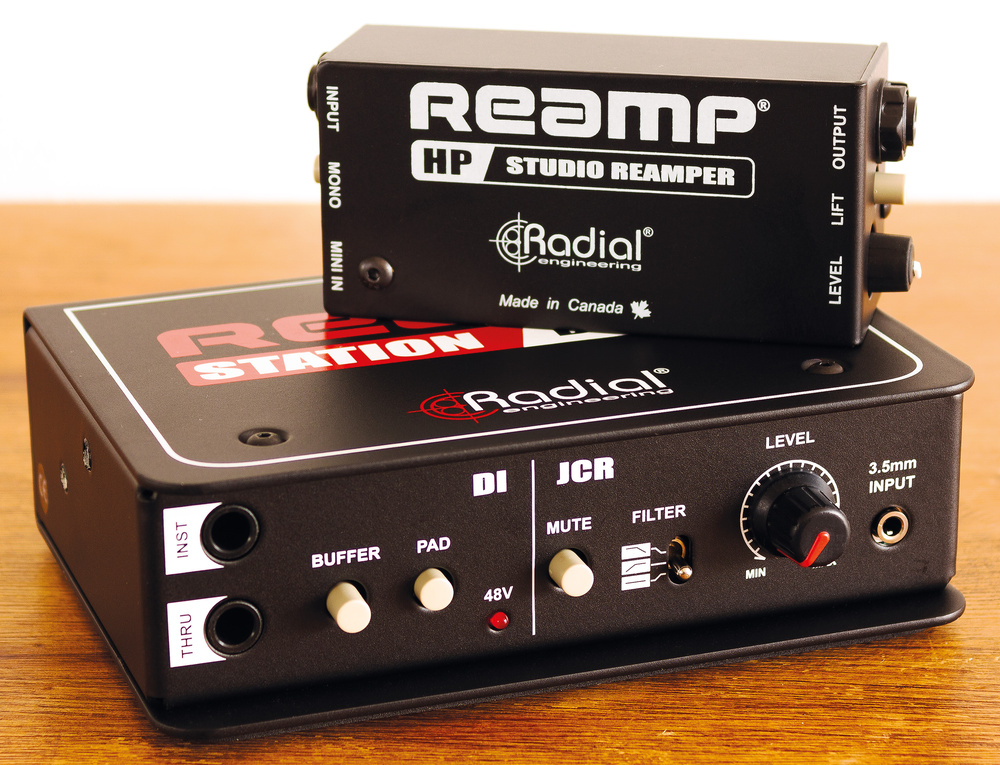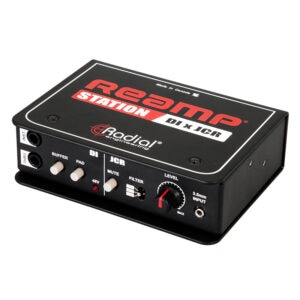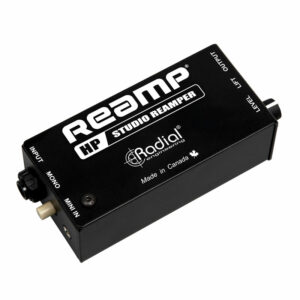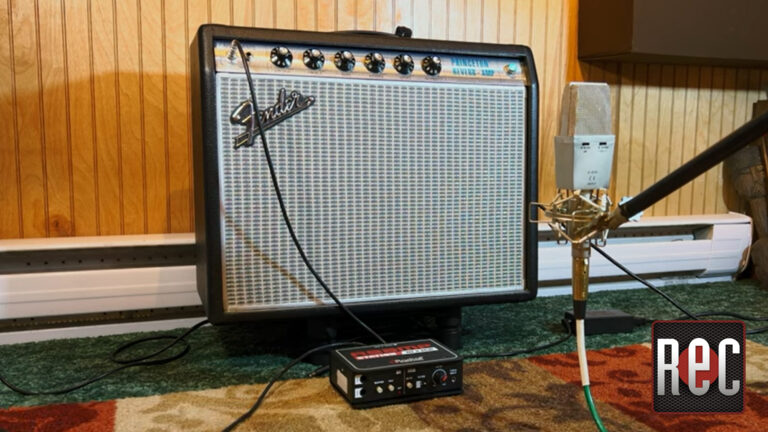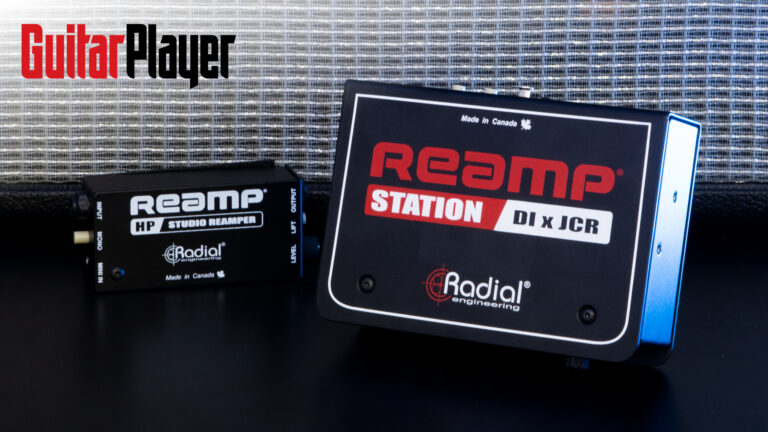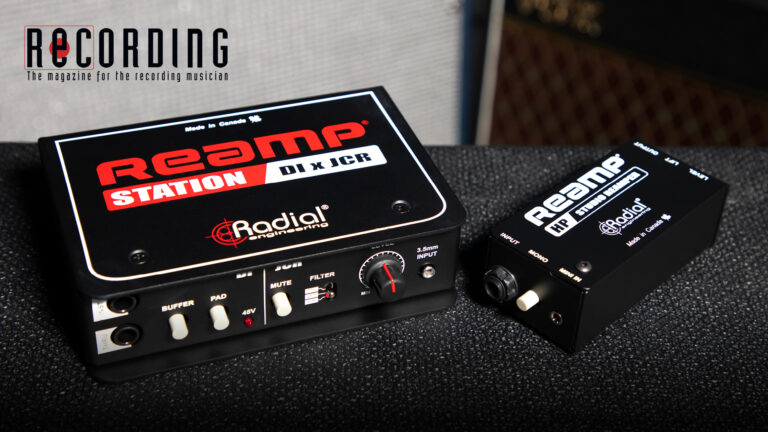The following review by
Radial Reamp® Station & Reamp® HP
DI & Reamp® Boxes
Ever wanted to run already recorded signals through a guitar amp or stompbox? One of these boxes could be all you need…
Electric guitars and basses fitted with passive pickup systems can be very fussy devices, particularly when it comes to the circuity they are plugged into. Similarly, electric guitar amplifiers need to see a guitar‑like level and source impedance to sound their best. This means some ‘trickery’ is required when interfacing guitars and amplifiers with studio equipment that’s designed to work with conventional mic‑ or line‑level signals — and that, of course, is where reamping and DI boxes come in. A suitable DI box can fool a guitar into thinking that it is connected to a typical guitar amp by presenting it with a suitable high‑impedance input, and can pass a balanced mic‑level signal on to a mic preamp (such as on a console or audio interface). A Reamp® box is used for signals headed in the opposite direction: it can fool a guitar amp into thinking it is being fed from a guitar, by converting a mic or line‑level signal to an unbalanced signal that has a more guitar‑like level and a suitable source impedance.
The practical advantage of using DI and Reamp® boxes together is that a clean guitar signal can be recorded via the DI box, even though the player may be listening to the sound of an amplifier fed from a thru connector. That clean signal can then be replayed via the reamping box to feed a miked guitar amplifier — this allows the engineer to try different amplifier setups and mic techniques after the recording has been made. There’s another practical application of a reamping setup, though, and that’s to allow pedals that have been designed for guitar to be used as outboard studio gear: just put the Reamp® box before the pedal and the DI box after it, and your stompbox delay or reverb (or whatever) can be used just like your studio gear when you’re mixing.
Radial have long been one of the biggest players when it comes to DI boxes, reampers and other such problem‑solving gadgets, and with good reason: they’ve always combined excellent circuit design with seriously heavy‑duty construction to create robust, high‑performance devices. They’ve already produced a number of reamping devices, in various form factors, and they’ve even registered the word Reamp® as a trademark. Recently, though, they’ve added a couple more reampers to their range. One, the Reamp® Station, terminates two ornithological entities utilising a single igneous projectile by putting both a Reamp® unit and an active DI in a single box — it’s not dissimilar in concept to their EXTC-SA, though the latter caters for two channels and this just one. The other, the Reamp® HP, is smaller and intended primarily as a way to interface headphone output signals with guitar amps (more on that one later).
Reamp® Station
The Reamp® Station has a very typical Radial style of construction, being made from heavy‑gauge folded steel, with a rubber foam‑padded base. There’s also an optional SA‑series rackmounting kit available. It’s a fairly busy box in terms of controls and connectors, so both the front and rear panels host these.
The active DI section is powered via phantom power, and it’s based on a slightly modified version of Radial’s well‑established J48 circuit. The reamping section uses the same circuity as the Reamp® JCR, and features a custom‑wound, US‑built transformer to convert line‑level signals into a suitable feed for guitar amps and pedals, and since this circuit is passive, you don’t need phantom power when it’s being used on its own, without the DI. A three‑position filter (flat, top cut or low cut) affects the Reamp® tone, and there’s a mute switch.

Input connections for the Reamp® section comprise an XLR and balanced quarter‑inch TRS jack, plus an unbalanced 3.5mm mini‑jack, whose left and right channels are summed to mono, the idea being to facilitate the connection of mobile devices to amps. The output is on an unbalanced quarter‑inch jack, which delivers a guitar‑level signal. A level control adjusts the signal level at the Amp Out jack, and this is most welcome, as it’s important to send the same level signal to the amplifier as it would receive from the actual guitar being used for the session.
The active DI, which has an unbalanced input on a quarter‑inch jack, takes a feed from the instrument while presenting it with the correct load, but in other regards it keeps the signal clean and uncoloured. A unity‑gain buffer can be switched in for the thru output to avoid unnecessary additional loading on passive pickups from the connected device, while a 15dB pad is available for use with high‑output active instruments. The thru connection would typically be used to send the instrument signal onwards to the amplifier being used to monitor the guitar during recording, but this can also be used as a recording source if you wish. A red LED lights to confirm that phantom power is being received.
Balanced quarter‑inch TRS jack link in and out connectors allow the daisy‑chaining of multiple Reamp® Stations, to cater for occasions when it’s necessary to feed the same source signal to two or more different amplifiers, which is a nice touch. A ground‑lift switch operates on the Reamp® inputs and on the DI output to break any ground loops. There’s also a polarity‑invert switch for the DI output, which can be helpful when you want to record and blend both the DI signal and a miked amp. The mic‑level XLR output from the DI stage can be connected directly to a mic preamp, whether on a console, an audio interface or standalone input for recording.
“The only factor that limits the quality of your signal will be the noise coming from your instrument’s pickups!”
Performance
It’s possible to write a lot of words about the features and design ethos of Radial’s DI and Reamp® pedals, but writing about their performance in practice demands far fewer words: being the professional products that they are, from an end‑user point of view they just get on with the job and work, with zero fuss. I found them to be exceptionally quiet, just as I’ve come to expect from Radial: there was no noticeable change in tonality when I compared the sound of the guitar patched directly into the amp with that of the reamped version. So, really, the only factor that limits the quality of your signal will be the noise coming from your instrument’s pickups!
That said, as I touched upon earlier, if you want to hear the same sound as playing a particular guitar through a particular amp, it’s important to get the level of the signal going back to the amp right, and it doesn’t hurt to use the same guitar cable either, as guitar cable capacitance also has an effect on tonality. The switchable EQ settings were not too heavy‑handed to my ears, and could certainly be useful in fine‑tuning a sound — but I had no problems just using the flat setting and then adjusting the amp to get the sound I wanted. In short, then, Radial have done it again: their Reamp® Station is a solid, reliable and transparent‑sounding solution to reamping.
Reamp® HP
Should you already have a suitable DI box, Radial provide an alternative reamping solution in the form of the Reamp® HP, which is billed as a ‘Studio Reamper’. Again this is a passive, transformer‑based design but forgoes some of the connection options as well as leaving out the filter and polarity‑invert functions.
Both the input and output are on quarter‑inch jacks but here the input is designed to accept the input from a headphone amp, either from its right channel only or, courtesy of a mono switch, from a sum of the left and right channels. This explains the HP in the product title, but I also found during my tests that the HP Studio Reamper worked happily if fed from a line output of my audio interface (though note that if connecting it in this way using a mono TS jack, the mono button will need to be set to ‘on’). You also get the 3.5mm TRS mini‑jack input option, but there are no XLR connections on this unit.

The quality of the end result is essentially the same as from the ‘big boy’ JCR Reamp® circuit and, of course, it’s priced much lower, so if this little box fits into your way of working and you already have a DI, you could save on both cost and space.
Pros
- Excellent sound quality.
- Built to withstand pro touring.
- Buffered thru connector.
Cons
- Absolutely no complaints.
Summary
Classic Radial: a pair of robust, high‑performance reamping tools.

